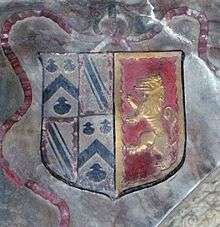Sir John Lyttelton (1520–1590)
Sir John Lyttelton (28 October 1519 – 15 February 1590) was an English nobleman, politician, knight, and landowner from the Lyttelton family during the Tudor period.
John Lyttelton | |
|---|---|
 The arms of Sir John Lyttelton's parents, combining Lyttelton and Talbot | |
| Born | 28 October 1519 |
| Died | 15 February 1590 |
| Nationality | English |
| Occupation | Politician and Knight |
| Title | Sir |
| Spouse(s) | Bridget Pakington |
| Children | Elizabeth Littleton, Sir Gilbert Lyttelton |
| Parent(s) | Sir John Littleton Elizabeth Talbot |
| Relatives | Sir William Littelton (grandfather) |
Biography

John Lyttelton was the son of Sir John Littleton (c. 1500–1533), son of Sir William Littleton (1450–1507), knighted after the Battle of Stoke, and his second wife, Mary Whittington, in turn the eldest son and heir of Sir Thomas de Littleton (d. 1481), justice and author of Littleton's Tenures.[1] His mother was Elizabeth (née Talbot, d. 1581), daughter and coheiress of Sir Gilbert Talbot of Grafton, Worcestershire (died 1542).[2] John Lyttelton's brother, George (1528–1600), became a prominent lawyer; there is a monument to him in St John the Baptist Church, Bromsgrove.
John Lyttelton was of age in 1541.[3] He was made Constable of Dudley Castle and keeper of the old and new parks there in 1553. He was knighted by Elizabeth I at Kenilworth in 1566. He was a Member of the Council of Wales and the Marches, a Deputy Lieutenant and a Justice of the Peace for Worcestershire.
He purchased the manor of Halesowen (formerly of Halesowen Abbey) from Lord Robert Dudley (later Earl of Leicester) in 1558.[4][5] He bought the manor of Hagley from John St. Leger in 1565.[6] These together with Frankley and Upper Arley (which he inherited) were the core of the family estate. Save that Upper Arley devolved away from the male line, this has remained in the hands of the family ever since, though parts were sold off in the 20th century.
Family and descendants
He married Bridget Pakington (b. 1522), the daughter of Sir John Pakington, by whom he had a daughter, Elizabeth Littleton (1546 – 4 June 1594), who in 1564 married Sir Francis Willoughby (d. 16 November 1596) of Wollaton Hall, Nottinghamshire.[7]
He was succeeded by his son Gilbert (c. 1570–1599), who was the father of John († 1601) and Humphrey († 1606).
Notes
- Baker 2007.
- Bernard & Birch 1738, p. 118.
- Jeayes 1893, no. 436.
- Jeayes 1893, nos. 440–401.
- VCH 1913a, pp. 136–146.
- VCH 1913, pp. 130–136, footnote 64: "Feet of F. Div. Co. Trin. 7 Eliz."
- Emerson 2013.
References
- Baker, J.H. (May 2007) [2004]. "Littleton, Sir Thomas (d. 1481)". Oxford Dictionary of National Biography (online ed.). Oxford University Press. doi:10.1093/ref:odnb/16787. (Subscription or UK public library membership required.)
- Bernard, John Peter; Birch, Thomas (1738). A General Dictionary Historical and Critical. III. p. 118. Retrieved 20 November 2013.CS1 maint: ref=harv (link)
- Jeayes, J.H. (1893). Descriptive catalogue of the charters and muniment of the Lyttelton Family.CS1 maint: ref=harv (link)
- Emerson, Kathy Lynn (2013). "Elizabeth Littleton (1546-June 4, 1594)". A Who’s Who of Tudor Women: L, compiled by Kathy Lynn Emerson to update and correct: Wives and Daughters: The Women of Sixteenth-Century England (1984). Archived from the original on 21 September 2013. Retrieved 20 November 2013.CS1 maint: ref=harv (link)
- VCH (1913). "Parishes: Hagley". A History of the County of Worcester. 3. Victoria County History. pp. 130–136 – via British History Online.CS1 maint: ref=harv (link)
- VCH (1913a). "Halesowen: Introduction, borough and manors". A History of the County of Worcester. 3. Victoria County History. pp. 136–146 – via British History Online.CS1 maint: ref=harv (link)
- Burkes Peerage and Baronetage (1939), s.v. Cobham, Viscount
| Honorary titles | ||
|---|---|---|
| Preceded by Sir Thomas Russell |
Custos Rotulorum of Worcestershire before 1577 – 1590 |
Succeeded by Sir John Pakington |